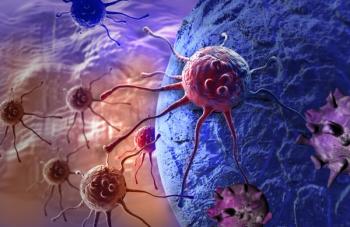
- ONCOLOGY Nurse Edition Vol 26 No 8
- Volume 26
- Issue 8
Falls in Older Adults With Cancer: A Call to Action
The prevention of patient falls is a major healthcare imperative. Falls are associated with avoidable morbidity and mortality, compromised quality of life, and considerable economic burden.
The prevention of patient falls is a major healthcare imperative. Falls are associated with avoidable morbidity and mortality, compromised quality of life, and considerable economic burden. Consider the following. Falls:
• Account for more than 70% of all injury-related admissions to hospitals for people over 65 years of age;
• Occur in approximately one-third of all people over age 65 and about half of all people over 80 years old;
• Are the leading cause of hip fractures;
• Promote loss of independence and are the main reason for admission to an extended-care facility;
• Are responsible for approximately 16,000 deaths per year in people over age 65; and
• Account for more than $19 billion in health-related expenses annually.[1–4]
Falling in old age is considered a geriatric syndrome, one element of a cluster of common age-related problems that frequently co-occur in practice. Other geriatric syndromes include altered continence, changes in mental status, immune senescence, malnutrition, depression, and skin compromise. In the context of falls, these geriatric syndromes frequently have roles in either causation or consequences.
For older cancer patients, falls can have critical negative sequelae. Older patients who fall may experience fracture, head injury, infection and delirium (if the fall occurs after required surgery), exacerbated bleeding, and prolonged hospitalizations. Despite the potentially serious consequences of falls in older cancer patients, however, definitive research in this area is lacking.
Two studies of older men treated with androgen-deprivation therapy for prostate cancer revealed that the treatment-associated accelerated osteoporosis, and functional and physical impairments (ie, fatigue, muscle weakness/wasting), could contribute to an increased risk of falls.[1,5] In the palliative care setting, the incidence of delirium, correlated with the common, frequently high use of neuroleptic medications, was associated with fall risk.[6]
Overcash and colleagues[7–9] reported on three domains of falls in older cancer patients. In one study, older patients were contacted by telephone following their fall to determine characteristics of the fall episode. The majority of falls occurred at home (75%), in a forward direction (55%).[7] The investigators noted 80% of the participants stated that, subsequent to the fall, they had changed behaviors they faulted as the cause. (For example, in an effort to prevent future falls, they limited activities during times they felt physically weak, and used assistive devices more often.)
A preliminary survey study noted that men were more likely to fall compared with women.[8] A third study, which investigated the impact of a comprehensive geriatric assessment on the incidence of falls, concluded that responses obtained from an activities of daily living screening could help to predict fall risk.[9] Community-dwelling elderly with a history of cancer were also the target of research by Spoelstra and colleagues, who reported a high frequency of falls in this group.[10] In the sample studied, symptomatic predictors of falling included the presence of incontinence, pain, and depression.
Although promoting a culture of safety is the entire interdisciplinary team’s shared responsibility, nurses are essential core members in achieving the level of healthcare provider commitment necessary to reduce patient falls.[11] Within cancer care, oncology nurses often drive initiatives to reduce actual and near-miss falls, as assessment and prevention are critical aspects of their professional role.
Assessment
Of fundamental importance is the fact that falls rarely have a single cause.[12] Rather, multiple intrinsic and extrinsic variables interface to precipitate falls. Within the cancer experience, intrinsic or host factors relate to individual characteristics that may heighten risk. These risk factors include:
• Altered mental status: mostly acute confusion but also organic dementia;
• Symptom distress: pain, incontinence (bowel and urinary), anemia/fatigue;
• Presence of comorbidity (ie, particularly arthritis, stroke, postural hypotension) and related polypharmacy (ie, especially use of benzodiazepines, sedatives/hypnotics, analgesics, antihistamines with the potential to alter cognitive function);
• Declining physical and functional status (ie, diagnosis of metastatic disease, malnutrition/cachexia, evidence of deconditioning);
• Changes in mobility (ie, altered gait, balance, endurance, strength); and
• Neurosensory compromise (ie, vision deficit, peripheral neurotoxicity, diagnosis of spinal cord compression with either motor/sensory changes).
Other factors that have been noted to increase fall risk include a prior history of falls and lack of social support (ie, patient lives alone).
TABLE 1
Extrinsic Modifications to Reduce Fall Risk
Prevention
The removal of risk factors is one category of major intervention to reduce falls.
• Using a screening tool to distinguish early and ongoing risk characteristics (particularly as the patient’s status changes over time);
• Clearly identifying patients at risk for falls;
• Educating the patient and family about risk profiles;
• Rigorous medication scrutiny:
– Removing medications potentially associated with adverse effects (ie, delirium, agitation);
– Managing symptom distress associate with unaccompanied mobility (ie, diarrhea, urinary frequency);
• Using bed and chair alarms for early reporting;
• Hourly rounding for needs assessment and toileting requirements; and
• Requesting a physical therapy consultation.[8,9,13]
Acknowledging cancer as a phenomenon of aging, falls take precedence as a major concern for oncology nurses-one that will grow in importance as the number of older adults with cancer increases in the future. The growing pool of cancer survivors will translate into an expansion of the number of older adults treated and monitored for the iatrogenic sequelae of cancer. The prevention of falls in this expanding population will become a critical competency for oncology nurses.
Financial Disclosure:The author has no significant financial interest or other relationship with the manufacturers of any products or providers of any service mentioned in this article.
References:
References
1. Hussain S, Breunis H, Timilshina N, et al: Falls in men on androgen deprivation therapy for prostate cancer. J Geriatr Oncol 1(1):32â39, 2010.
2. Stevens JA, Corso PS, Finkelstein EA, et al: The costs of fatal and non-fatal falls among older adults. Injury Prevent 12(5):290â295, 2006.
3. Centers for Disease Control and Prevention: Self-reported falls and fall-related injuries among persons aged > or = 65 years-United States, 2006. MMWR Morb Mortal Wkly Rep 57(9):225â229, 2008.
4. Kannus P, Sievänen H, Palvanen M, et al: Prevention of falls and consequent injuries in elderly people. Lancet 366(9500):1885â1893, 2005.
5. Bylow K, Dale W, Mustian K, et al: Falls and physical performance deficits in older patients with prostate cancer undergoing androgen deprivation therapy. Urology 72(2):422â427, 2008.
6. Pauteux S, Herrmann FR, Zulian GB: Factors associated with falls in patients with cancer hospitalized for palliative care. J Palliat Med 11(6):878â884, 2008.
7. Overcash JA, Rivera HR, Van Schaick J: An analysis of falls experienced by older adult patients diagnosed with cancer. Oncol Nurs Forum 37(5):573â580, 2010.
8. Overcash J: Prediction of falls in older adults with cancer: A preliminary survey. Oncol Nurs Forum 34(2):341â346, 2007. 9. Overcash, Beckstead J: Predicting falls in older patients using components of a comprehensive geriatric assessment. Clin J Oncol Nurs 12(6):941â949, 2008.
10. Spoelstra S, Given B, Von Eye A, et al: Falls in the community-dwelling elderly with a history of cancer. Cancer Nurs 33(2):149â155, 2010.
11. Gray-Miceli D: Preventing falls in acute care. In: Capezuti E, Zwicker D, Mezey M, et al, eds. Evidence-Based Geriatric Nursing Protocols for Best Practice. Ed 3. New York, NY: Springer Publishing; 2008:161â198.
12. Holley S: A look at the problem of falls among people with cancer. Clin J Oncol Nurs 6(4):193â197, 2002.
13. Miller L, Limbaugh CM: Applying evidence to develop a medical oncology fall-prevention program. Clin J Oncol Nurs 12(1):158â160, 2008.
Articles in this issue
over 13 years ago
News of Noteover 13 years ago
Evolving and Expanding Treatment Options in NSCLCover 13 years ago
What's in a Number?over 13 years ago
Current Treatment Options for Non–Small-Cell Lung Cancerover 13 years ago
A Patient With Tumor Lysis Syndromeover 13 years ago
Clinical Hypnosis for the Palliative Care of Cancer Patientsover 13 years ago
Contemporary Issues in NSCLCNewsletter
Stay up to date on recent advances in the multidisciplinary approach to cancer.

















































































